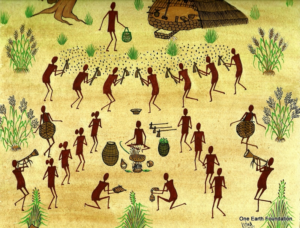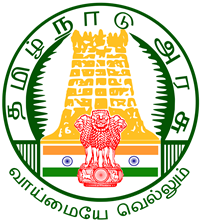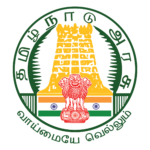 Kurumba art is a unique tribal art form found in the Nilgiris. Eluthu paarai is an ancient 3000- year-old rock-art site in the Kotagiri region of the Nilgiris. The Kurumbas – a tribe of hunters and medicine men – believe that the art was the work of their ancestors. The Kurumbas are generally believed to be the descendants of the Pallavas whose rule was at its grandest in the 7th century. Losing power to the Kongus and the Chalukyas, the Pallavas were finally driven out and dispersed by the Chola king Adondai. It is the Kurumbas of the Nilgiris Whom we refer to when we say “Kurumba”.The tribe is divided into several groups. In The many ethnographic accounts of the tribe the numbers vary from as few as three to as many as seven. The various groups are the jen (orsola nayakkars”), mullu, urali, beta and aluor palu. The most populous of these are the AluKurumbas. Four colors are used traditionally:Red (“Semm manna”) and white (“Bodhi manna”) are soils,black is obtained from the bark of a tree (“Kari maran”) and green from the leaves of a plant(“Kata Avarai sedi”). A piece of cloth is used to apply the colors onto the cow dung prepared walls. These paintings look more like village scenes. In most of the paintings, there is a hut or a tree in the center and all the activities and actions are happening around the tree. As these tribes are hunters we also see tree houses in their paintings. The canvas for the painting is the outerwall of the temple and the house. The figures representing their gods and the kurumba man expresses Kurumba beliefs and the milestones of the village and the tribe. The artist also draws inspiration from his life. The figures are made up of lines and are minimal in style. Lines,independent and concentric, dot and simple geometric figures are the basic elements The art is primarily ritualistic, describing various facets of tribal life in the remote forests of theNilgiris. We see the Kurumba huts built of leaves and wood, women drying foodgrains, men collecting honey, weddings and rituals, earthen pens for hens, and wild animals prowling the forest. The Kurumbas love the hills and have an exquisite style of art. Originally, they drew withburnt twigs and coloured the art with a resin extracted from the bark of the Kino tree (Pterocarpus marsupium). Some of the art still use this method, which is slow and cumbersome,but beautiful. On paper, they have learned to use water and poster colors, which flow easier. The Choice of themes became more versatile as they gained confidence, and their choice varied from the vegetables and tubers to weddings and functions in their community. The depictions were of nature – trees and mountains, driving away bees while gathering honey, weddings and festivals.The solemnity of tribal life with prayers to the forefathers and communal participation at every stage of life was also brought out in the art. The Kurumbas fairly are now well accomplished and artistically skilled. But they need support in the ensuring months, so that more youth has exposure to their arts. It is imperative to continue their practice, to aim for perfection and marketing of the artifacts. The Kurumba art is an expression of its socio-religious fabric. The artist traditionally practiced by the male members of the temple caretakers, or priests to the Kurumba Village. The women of the family contribute to the decorations at home in the form of borders around the door and windows and kolams on the floor. Other Kurumbas are not allowed to practice the art.
Kurumba art is a unique tribal art form found in the Nilgiris. Eluthu paarai is an ancient 3000- year-old rock-art site in the Kotagiri region of the Nilgiris. The Kurumbas – a tribe of hunters and medicine men – believe that the art was the work of their ancestors. The Kurumbas are generally believed to be the descendants of the Pallavas whose rule was at its grandest in the 7th century. Losing power to the Kongus and the Chalukyas, the Pallavas were finally driven out and dispersed by the Chola king Adondai. It is the Kurumbas of the Nilgiris Whom we refer to when we say “Kurumba”.The tribe is divided into several groups. In The many ethnographic accounts of the tribe the numbers vary from as few as three to as many as seven. The various groups are the jen (orsola nayakkars”), mullu, urali, beta and aluor palu. The most populous of these are the AluKurumbas. Four colors are used traditionally:Red (“Semm manna”) and white (“Bodhi manna”) are soils,black is obtained from the bark of a tree (“Kari maran”) and green from the leaves of a plant(“Kata Avarai sedi”). A piece of cloth is used to apply the colors onto the cow dung prepared walls. These paintings look more like village scenes. In most of the paintings, there is a hut or a tree in the center and all the activities and actions are happening around the tree. As these tribes are hunters we also see tree houses in their paintings. The canvas for the painting is the outerwall of the temple and the house. The figures representing their gods and the kurumba man expresses Kurumba beliefs and the milestones of the village and the tribe. The artist also draws inspiration from his life. The figures are made up of lines and are minimal in style. Lines,independent and concentric, dot and simple geometric figures are the basic elements The art is primarily ritualistic, describing various facets of tribal life in the remote forests of theNilgiris. We see the Kurumba huts built of leaves and wood, women drying foodgrains, men collecting honey, weddings and rituals, earthen pens for hens, and wild animals prowling the forest. The Kurumbas love the hills and have an exquisite style of art. Originally, they drew withburnt twigs and coloured the art with a resin extracted from the bark of the Kino tree (Pterocarpus marsupium). Some of the art still use this method, which is slow and cumbersome,but beautiful. On paper, they have learned to use water and poster colors, which flow easier. The Choice of themes became more versatile as they gained confidence, and their choice varied from the vegetables and tubers to weddings and functions in their community. The depictions were of nature – trees and mountains, driving away bees while gathering honey, weddings and festivals.The solemnity of tribal life with prayers to the forefathers and communal participation at every stage of life was also brought out in the art. The Kurumbas fairly are now well accomplished and artistically skilled. But they need support in the ensuring months, so that more youth has exposure to their arts. It is imperative to continue their practice, to aim for perfection and marketing of the artifacts. The Kurumba art is an expression of its socio-religious fabric. The artist traditionally practiced by the male members of the temple caretakers, or priests to the Kurumba Village. The women of the family contribute to the decorations at home in the form of borders around the door and windows and kolams on the floor. Other Kurumbas are not allowed to practice the art.


